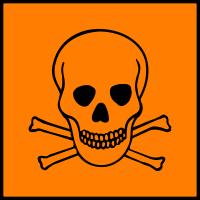|
Storage Condition
|
|
2-8°C, Desiccate
|
 Show
data source Show
data source
|
|
|
Storage Warning
|
|
Moisture Sensitive
|
 Show
data source Show
data source
|
|
Toxic/Corrosive/Lachrymatory/Moisture Sensitive/Store under Argon
|
 Show
data source Show
data source
|
|
|
RTECS
|
|
KI2950000
|
 Show
data source Show
data source
|
|
|
European Hazard Symbols
|
 Corrosive (C) Corrosive (C)
|
 Show
data source Show
data source
|
 Toxic (T) Toxic (T)
|
 Show
data source Show
data source
|
|
|
UN Number
|
|
2922
|
 Show
data source Show
data source
|
|
2927
|
 Show
data source Show
data source
|
|
UN2927
|
 Show
data source Show
data source
|
|
|
MSDS Link
|
|
|
German water hazard class
|
|
2
|
 Show
data source Show
data source
|
|
|
Hazard Class
|
|
6.1
|
 Show
data source Show
data source
|
|
8
|
 Show
data source Show
data source
|
|
|
Packing Group
|
|
1
|
 Show
data source Show
data source
|
|
2
|
 Show
data source Show
data source
|
|
II
|
 Show
data source Show
data source
|
|
|
Australian Hazchem
|
|
2XE
|
 Show
data source Show
data source
|
|
|
Risk Statements
|
|
14-22-23-29-34
|
 Show
data source Show
data source
|
|
14-23-29-34
|
 Show
data source Show
data source
|
|
14-23-29-34-37
|
 Show
data source Show
data source
|
|
14-23-29-34-37-40
|
 Show
data source Show
data source
|
|
R:14-22-34
|
 Show
data source Show
data source
|
|
|
Safety Statements
|
|
26-36/37/39-45
|
 Show
data source Show
data source
|
|
4-7/8-9-20-23-26-30-36/37/39-45-60
|
 Show
data source Show
data source
|
|
S:27/28-30-36/37/39-45
|
 Show
data source Show
data source
|
|
|
EU Classification
|
|
CT1
|
 Show
data source Show
data source
|
|
|
EU Hazard Identification Number
|
|
8B
|
 Show
data source Show
data source
|
|
|
Emergency Response Guidebook(ERG) Number
|
|
154
|
 Show
data source Show
data source
|
|
|
TSCA Listed
|
|
是
|
 Show
data source Show
data source
|
|
|
GHS Pictograms
|

|
 Show
data source Show
data source
|

|
 Show
data source Show
data source
|

|
 Show
data source Show
data source
|

|
 Show
data source Show
data source
|
|
|
GHS Signal Word
|
|
Danger
|
 Show
data source Show
data source
|
|
|
NFPA704
|
|
|
 Show
data source Show
data source
|
|
|
GHS Hazard statements
|
|
H314-H331
|
 Show
data source Show
data source
|
|
H314-H331-H335
|
 Show
data source Show
data source
|
|
H314-H332-H335-H351
|
 Show
data source Show
data source
|
|
H331-H302-H314-H318
|
 Show
data source Show
data source
|
|
|
GHS Precautionary statements
|
|
P261-P280-P305 + P351 + P338-P310
|
 Show
data source Show
data source
|
|
P280-P303+P361+P353-P305+P351+P338-P310-P402+P404
|
 Show
data source Show
data source
|
|
|
Personal Protective Equipment
|
|
Faceshields, full-face respirator (US), Gloves, Goggles, multi-purpose combination respirator cartridge (US)
|
 Show
data source Show
data source
|
|
Faceshields, full-face respirator (US), Gloves, Goggles, multi-purpose combination respirator cartridge (US), type ABEK (EN14387) respirator filter
|
 Show
data source Show
data source
|
|
|
RID/ADR
|
|
UN 2922 8/PG 1
|
 Show
data source Show
data source
|
|
UN 2927 6.1/PG 2
|
 Show
data source Show
data source
|
|
|
Supplemental Hazard Statements
|
|
Contact with water liberates toxic gas., Reacts violently with water.
|
 Show
data source Show
data source
|
|